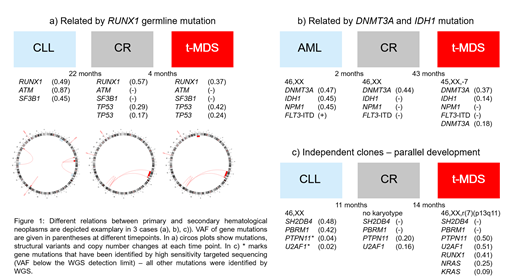Background: The pathogenesis of secondary hematological neoplasms occurring after a primary hematological neoplasm and the relationship between both is still unclear. We set up this study in order to evaluate whether both diseases share genomic alterations.
Patients and Methods: We selected 25 patients who were diagnosed with a first hematological neoplasm (FHN) (CLL: n=14, other mature B cell neoplasm: n=6, AML: n=4, CML: n=1) and in median 48 months later (range: 16-119) with a second hematological neoplasm (SHN) (t-MDS: n= 21; t-AML: n=1, CMML: n=1; t-MPN: n=1, t-MDS/MPN: n=1). In 9 cases bone marrow was available that had been drawn in complete cytomorphological remission (CR) between FHN and SHN. Whole genome sequencing was performed for all 59 samples: 150 bp paired-end sequences where generated on Illumina HiseqX and NovaSeq 6000 machines (Illumina, San Diego, CA, USA) (median coverage 106x). A mixture of genomic DNA from multiple anonymous donors was used as normal controls. The overlap of genomic alterations present at the different points in time was evaluated. For the assessment of mutations as germline the following parameters were considered: a) variant allele frequency (VAF) 0.4-0.6; b) gnomAD frequency <0.005%; c) CLINVAR entry; d) high pathogenicity rating in the HePPy predictor (Hutter et al. ASH 2019) based on the most common in silico predictors included in dbNSFP.
Results: 1) Relation of FHN and SHN by germline variants: In 8 cases 10 variants with a high pathogenicity in silico MLL predictor score in cancer predisposition genes were found (TP53,RUNX1, GATA2, BRCA2, MLH1, FAM175A, TMEM127, PALB2, ANKRD26, and PMS2). However, in CLINVAR only variants in GATA2 and PMS2 were scored as pathogenic/likely pathogenic, while for all other variants either no or conflicting data were available.
2) Relation of FHN and SHN by acquired mutations: A NOTCH2 mutation was detected at the time of CLL diagnosis (VAF 0.42) as well as at the time of t-MDS diagnosis (VAF 0.44) 16 months later, which might be either germline or somatic relating both diseases. In none of the remaining 19 pairs of a primary lymphatic neoplasm and a secondary myeloid neoplasm, there was evidence for shared acquired mutations. Regarding primary myeloid neoplasms, in one NPM1 mutated AML case an IDH1 mutation was present at AML and at t-MDS stage (VAF 0.45; 0.14), while it was not detectable in CR (2 months after diagnosis of AML and 43 months prior to diagnosis of t-MDS). In this case one DNMT3A mutation was present at all 3 points in time (VAF: 0.47, 0.44; 0.37), while a second one was gained at MDS stage (figure 1). No shared acquired mutations were identified between primary and secondary myeloid neoplasm in the remaining cases.
3) Independent/parallel development of FHN and SHN: In 5/9 cases with an available CR sample, mutations, structural variants and/or copy number variations present in the secondary malignancy were already detectable in CR. These included mutations in TP53 (n=3), AHR (n=1), CSNK1A1 (n=1), ASXL2 (n=1), t(2;3)(p16;q26) (n=1), del(2q), del(5q) and del(7p) (n=1). In 3/16 cases without remission sample a clone of the later emerging second neoplasm could be identified in the sample drawn at the time point of diagnosis of the primary disease. These clones harbored mutations in SRSF2 (n=2), PTPN11 (n=1), U2AF1 (n=1), WNK1 (n=1), MLH1 (n=1), TET2 (n=1). These secondary neoplasms were diagnosed 24, 24, and 76 months after the primary neoplasm, respectively.
Summary: In more than half of the cases no genetic relation between the first and second hematological neoplasm was identified. Remarkably, in several cases a parallel development of FHN and SHN was observed suggesting that therapy for FNH allowed the outgrowth of SHN.
Haferlach:MLL Munich Leukemia Laboratory: Employment, Equity Ownership. Baer:MLL Munich Leukemia Laboratory: Employment. Hutter:MLL Munich Leukemia Laboratory: Employment. Stengel:MLL Munich Leukemia Laboratory: Employment. Nadarajah:MLL Munich Leukemia Laboratory: Employment. Walter:MLL Munich Leukemia Laboratory: Employment. Meggendorfer:MLL Munich Leukemia Laboratory: Employment. Kern:MLL Munich Leukemia Laboratory: Employment, Equity Ownership. Haferlach:MLL Munich Leukemia Laboratory: Employment, Equity Ownership.
Author notes
Asterisk with author names denotes non-ASH members.


This feature is available to Subscribers Only
Sign In or Create an Account Close Modal